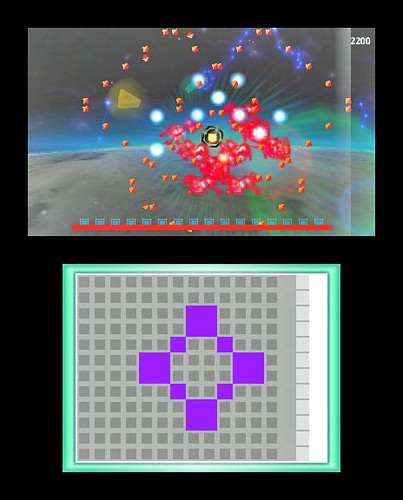The best dreams usually don’t make sense. On the same token, some games are so unique that they’re hard to define. Dream Trigger is one such title, which can only be described as an LSD induced love child between wireframe shooter Rez and the music puzzle game Lumines. Mix that in with the hectic action of a vertical shooter and you get an enjoyable, addictive romp through a world of dreams. But like most good dreams, this one’s over way too soon.
Dream Trigger doesn’t have a deep story. It doesn’t really even have a story at all. The premise is as straightforward as can be, where you control your little dream guy through over 50 worlds with while fighting off waves of enemies and vicious bosses. That’s nothing new, but before you label me a liar about the innovation, the catch lies in the game play.

First, the enemies aren’t visible on the screen, at least not at first. The top screen is where the action takes place, but the bottom screen displays a type of chart that show where enemies are located. The only way to see them, (besides waiting for them to glow before an attack,) is by predicting where they’ll be based on their patterns and placing sonar pings on the bottom screen. A rhythm bar, (a la Lumines,) scrolls across the bottom screen at the pace of the music and pings that are caught in it reveal enemies in its range. Exposing enemies grants power to attack by setting off a strobe light effect around your guy and adding in an awesome music track while slamming into enemies. Attacking also makes you invincible, so it becomes a balancing act between attacking as many enemies as possible to boost your score or using precious meter to avoid an attack.
I know it sounds complicated, and it’s honestly overwhelming to manage two screens and avoid attacks at the same time, but after some practice, it quickly becomes second nature. Besides, revealing enemies and attacking isn’t the only way to build power, because power ups that appear throughout the stages. While not usually notable, this is where the 3D really comes in handy, and is one of the first examples of the 3D feature being used to enhance the game rather than forcing it in just because. The power ups start below you and can’t be grabbed, but as they get closer, their depth increases until you can grab them. And if you miss… you have to watch them float helplessly towards the screen. How sad…

But the saddest part about Dream Trigger is the severe lack of content in the game. Despite the beautiful backgrounds, crazy visuals and addictive game play, after playing 30 or 40 stages that don’t differ much from one another, it starts to get really routine. The last 10 stages or so get more aggressive, but because most of the enemies and bosses used the same tactics, patterns and strategies, the game was a complete breeze outside of the learning curve at the beginning. Yeah… that will happen when you reuse each boss about ten times each. Sure, there’s a type of bonus stage where colliding with an enemy on the map makes you play that stage with fewer sonar pings and instant death instead of the usual four hits, but even this was passable when knowing how to approach the same enemies.
And while I’m an achievement whore, the worst part of the game has to be the achievement system. The game could have been easily over and done with in about half the time it took me, but the game requires you to track down the achievements in order for new stages to be unlocked. Most of them are secret, and some that aren’t are explained in riddles, so I spent a good hour or two replaying stages to test out theories or grind for the score goals. Note to developers: it’s not a good idea to force your audience to perform repetitive tasks to give the game a few more hours of life.

Dream Trigger is a great experiment with both the 3D technology being used as more than a visual trick and a new take on multiple genres. It’s too bad that most gamers would see it as a nightmare to drop $40 on only a few hours of enjoyment, which wouldn’t be a problem to me if there was more variety. But when many of the stages feel like you played them five times on a first run and the extra modes outside of the campaign are playing the same stages in either score attack or time attack, only the most hardcore dreamers will continue to play after the credits roll, (if they get that far considering the frustrating progression system.) While Dream Trigger is highly enjoyable while it lasts, those hoping that this could be a surprise must buy for the 3DS will have to keep dreaming.